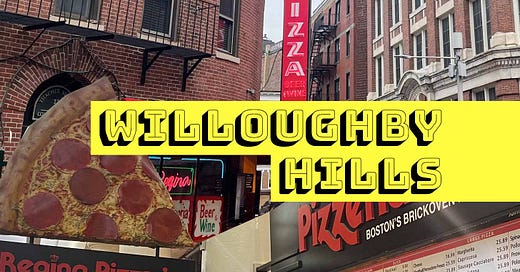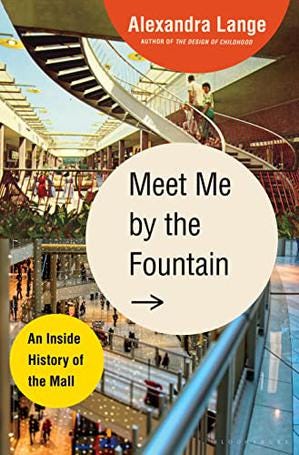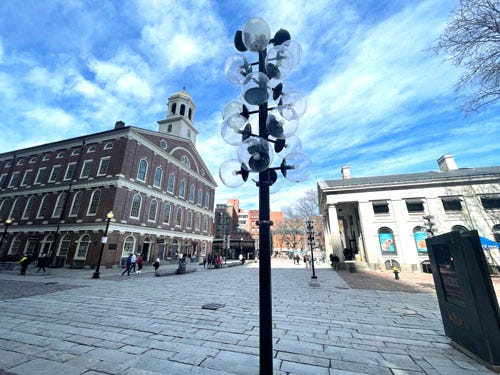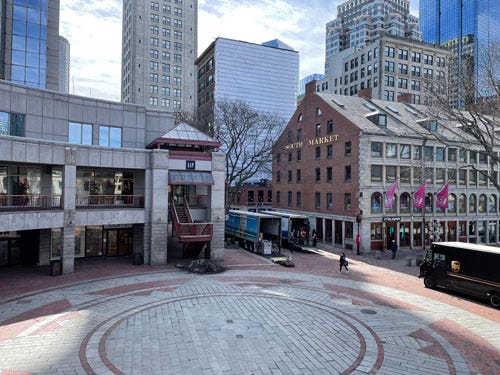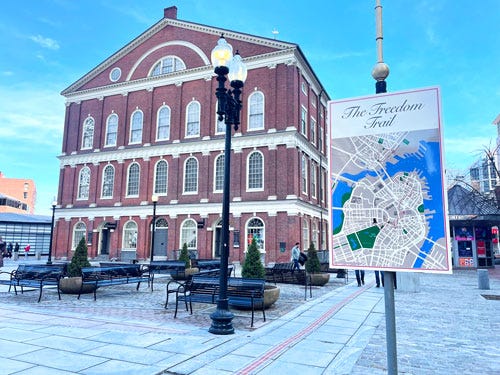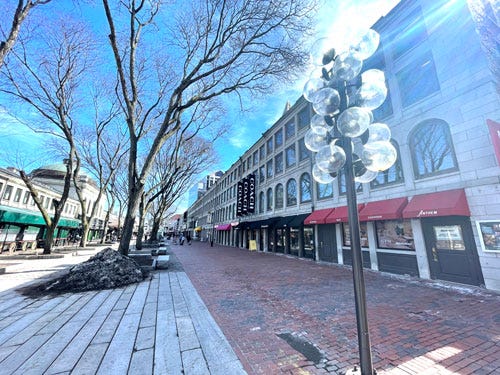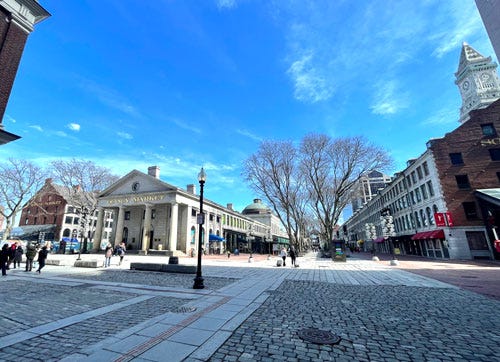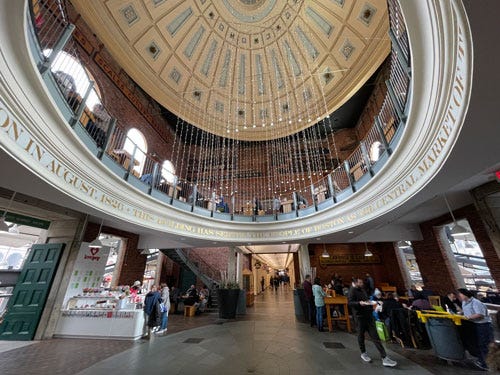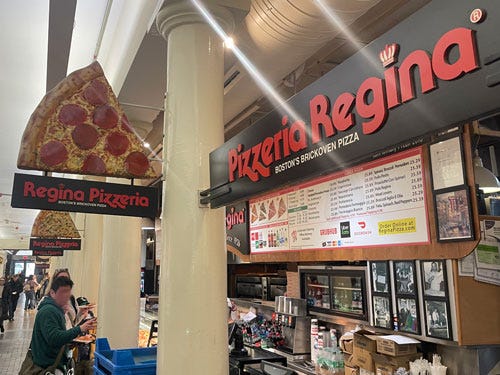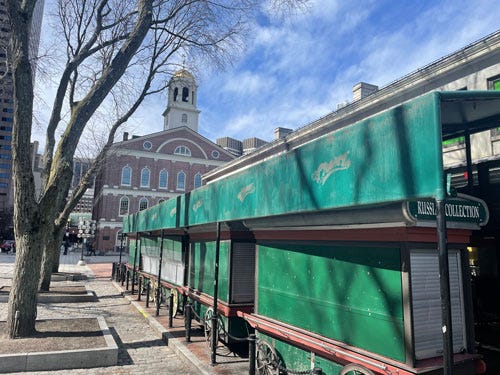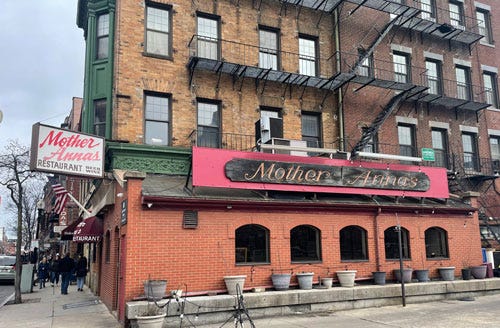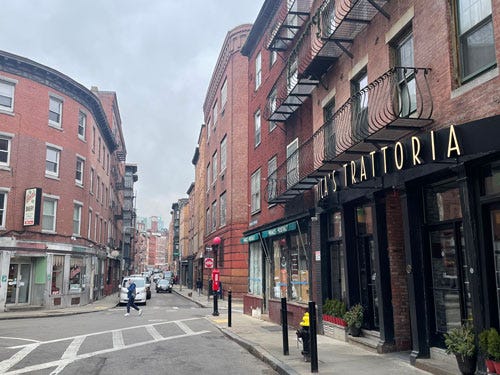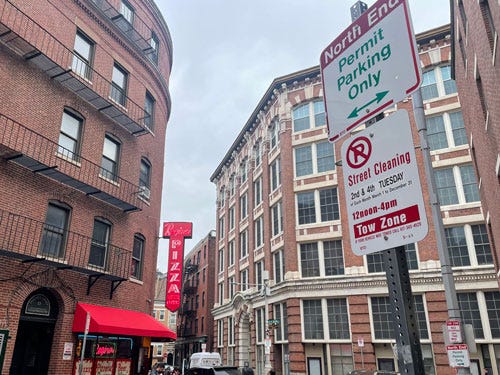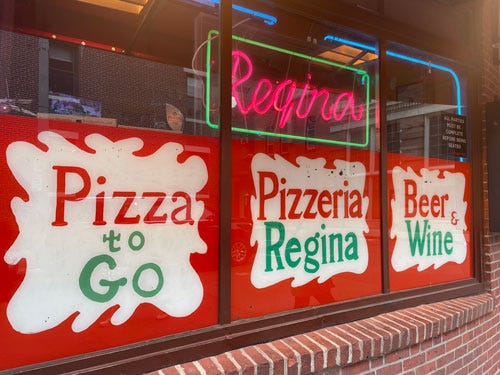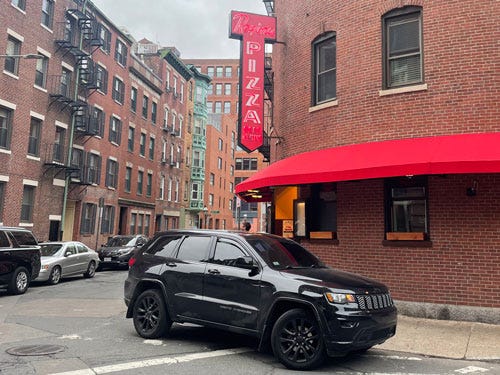Faneuil Hall, the North End, and the "True" Boston
What's the more authentic experience and who gets to define that?
Welcome to another edition of Willoughby Hills!
This newsletter explores topics like history, culture, work, urbanism, transportation, travel, agriculture, self-sufficiency, and more.
If you like what you’re reading, you can sign up for a free subscription to have this newsletter delivered to your inbox every Wednesday and Sunday:
In case you missed it, I just announced that there will now be a Willoughby Hills podcast! It will be available for members to stream on Monday (it will be available to the general public on Thursday). The first guest on this new incarnation of the podcast is author Alexandra Lange, whose latest book is called Meet Me at the Fountain: An Inside History of the Mall.
In the book, Lange dives into the architectural and sociological history of shopping malls. During the 1950s and 1960s, enclosed, climate-controlled shopping malls built in the suburbs were drawing business away from the city centers. By the 1970s though, downtowns were looking for ways to bring back some of that foot traffic.
Here is how Lange explains the way that cities were seen in the 1970s:
“For more than twenty years, the narrative of American downtowns had been blight and destruction. Stores closed, buildings demolished, highways built. An evacuation of social and cultural life, and of spaces that had once been pedestrian, urbane, and central to business, in favor of infrastructure for cars. The only way to save downtown, the narrative went, was to make it more like the suburbs.”
Some cities built indoor suburban shopping malls in the middle of downtown, often cut off from the surrounding streets. However, there were also attempts to try to translate the lessons of the suburban shopping mall to the existing urban fabric without just making a facsimile; adapting the best lessons of the suburbs while still fitting with the urban surroundings.
One of the early success stories in this space was the revitalization of Faneuil Hall Marketplace in Boston. The centerpiece of this collection of buildings is Faneuil Hall, a brick building topped with a gold dome that dates to 1742. The adjacent market buildings were built in the 1800s and at one time, the area served as one of Boston’s central shopping areas.
By the 1970s, though, the market area had fallen into disrepair. Many of the buildings were vacant and the site was slated for demolition. Mall developer James Rouse and architects Benjamin and Jane Thompson, with the support of Boston mayor Kevin White, took on the challenge of updating the marketplace.
Lange explained the vision for the redevelopment:
“Rather than new boxes, the frame would be old buildings. Rather than chain stores, the businesses would be quirky and local. Rather than fast food, the cafés would sell fresh pastries and the delis fresh fish.”
When Faneuil Hall Marketplace reopened in 1976, it was met with fanfare and was quickly copied in many other cities across the country. Rouse and the Thompsons collaborated together again on both Harborplace in Baltimore and New York’s South Street Seaport and many other cities tried their own version of Faneuil Hall. According to Lange:
“The opening of Faneuil Hall and Quincy Market was treated as a game changer for cities. Finally, a solution to what ailed downtown! Surely every city had a brick warehouse, even more than one, that, with added globe lights and exposed beams, cheese counters and café tables and wooden toys, could become a hub of activity after offices closed and parking garages emptied out. The banners and jugglers and carts gave the pedestrian walk between the old buildings the aspect of a fair, and thus a new name was spawned: the festival marketplace.”
Lange cites that between 1970 and 1988, one hundred new downtown shopping areas opened. My hometown of Cleveland had two urban malls that opened in my childhood. I recently revisited them and was saddened to see their current state.
Lange’s book provided new context of how Faneuil Hall fit in the history of retail. It was fascinating to me!
As a Massachusetts resident for nearly two decades, I’ve always thought of Faneuil Hall as mostly a tourist trap. It sits on the Freedom Trail, a walking path that connects many historic sites in Boston. My most vivid memory of it was visiting with my uncle when I was considering moving out here. I would walk through it occasionally after moving here and often brought out of town visitors to the area, but it wasn’t central to my experience of Boston as a local.
Learning Faneuil Hall’s place in retail history, it felt like it was worth revisiting and reexamining, so on a recent lunch break when I was working in Boston, I decided to do just that.
In her book, Lange had described the developer’s vision of local merchants selling their wares. There’s still some of that, though the local businesses are mostly T-shirt shops or other businesses designed to attract tourists. Some mall chains have crept in as well, with Urban Outfitters, Gap, Abercrombie and Fitch, Sephora, Kate Spade, and a Crocs store sitting among the local tenants (although, strictly speaking, some of these stores are adjacent to the Marketplace but are not officially a part of it).
Lange described in her book how the DNA of the mall is very present in Faneuil Hall:
“The easiest way to think of Faneuil Hall is as a shopping mall whose anchor stores are Boston City Hall and the waterfront. Those two draws attract politicians, government workers, document seekers, and tourists daily. Between them the long, narrow market buildings flank a pedestrian street, with benches, plantings, and lighting creating a corridor for walking and people-watching.”
My visit was on a cold winter day when the cobblestone sidewalks were mostly empty, but I know that in the summertime, this is an area that attracts musicians, magicians, and other street performers, which adds life.
Even walking the empty sidewalks though, I could see the analogy to a shopping malls in ways that I hadn’t appreciated in the past. Unlike individual businesses on a city street, there’s a continuity to Faneuil Hall that’s reminiscent of malls. Everything fits together and makes sense as both discreet parts and as a complete whole. The boundaries between “city” and “mall” are pretty well defined. Even if there’s not a set of glass doors to open like there would be when entering a mall, it’s clear when you’ve left the city and entered the Marketplace.
At the center of the Faneuil Hall Marketplace is Quincy Market, which opened in 1826. During the renovations in the 1970s, Quincy Market’s first floor was converted into a food court.
Architecturally, I was impressed with how the designs of the Thompsons still held up. There’s a dramatic atrium at the crossroads of the food court, not unlike what would be seen in a traditional shopping mall, and the outside walkways were covered with glass panels to form a hybrid indoor/outdoor space for small vendors to sell wares.
The food vendors in Quincy Market are still mostly small businesses. There is no McDonald’s, Chipotle, or Subway in the ranks.
One of the food stands at Quincy Market is Regina Pizzeria, which is a bit of a strange local chain. It has a presence in many local mall foodcourts in Massachusetts, from Burlington to Cape Cod. There are even Regina outlets at Fenway Park and Foxwoods Casino in Connecticut. It functions a bit like a Sbarro, selling pizza by the slice, plus a few other Italian specialities.
As I passed the Regina Pizzeria booth at Quincy Market, I saw a family of what appeared to be tourists ordering pizza. A part of me wanted to stop them and let them in on some insider local information.
Perhaps they didn’t know, but Regina Pizzeria started out as a single restaurant in 1926 in Boston’s North End. That restaurant still operates and is about a 10 minute walk from Faneuil Hall, though it goes by the name Regina Pizza to distinguish itself from the fast food version.
I stopped myself from intervening. After all, I was making a lot of assumptions about the situation. Were these people tourists or were they locals? Were they after the most authentic Italian meal or were they grabbing something that was quick and affordable so that they could see other sites on their agenda?
I suppose part of why I wanted to offer this tip to a random visiting family came from my own belief that there was something about the Faneuil Hall experience that wasn’t the “real Boston.” For years, there was a replica version of the bar from Cheers in Quincy Market, while the real exterior location was nearby in Beacon Hill (I’ve written about it before). Faneuil Hall has a miniature Samuel Adams brewery, while the “real” facility is a subway ride away in Jamaica Plain. There’s even a Margaritaville under construction, which doesn’t exactly evoke Minutemen or lobsterers.
Even though I didn’t encourage those tourists to visit the North End, I realized it had been a while since I had been there. With a few minutes left on my lunch break, I decided to take a walk through the neighborhood and see if my memory of it being a fun and vibrant neighborhood still held true.
The North End was once home to Boston’s elite. Paul Revere’s house is still preserved as a tourist site, as is the Old North Church, where lanterns announced the arrival of the British during the Revolutionary War, prompting Revere’s famous horse ride.
By the early 1800s, the wealthy had moved on to other neighborhoods and the North End became a neighborhood for recent immigrants to establish roots. This started with English, German, and Irish settlers. By the mid 1800s, it was transforming into a Jewish neighborhood, primarily made of immigrants from Russia and Poland. Immigrants from Italy began arriving in the late 1880s, and by the early 1900s, the North End was transforming into Boston’s Little Italy.
The North End is made up of narrow, winding streets lined with roughly three to five story brick apartment buildings. Urbanist Jane Jacobs opens her 1961 classic The Death and Life of Great American Cities in this neighborhood, describing two visits to the North End.
Jacobs first visit was in the late 1930s. She describes it as “badly overcrowded” and “desperately poor” at that time. When she visits again in the winter of 1959, she is amazed at the vitality of the neighborhood after a generation of local investment by the residents (without much outside support from banks or the local government). Jacobs calls up a Boston city planner friend to report her excitement with all that she is seeing in the vibrant North End. The planner dismisses the neighborhood and says it’s a slum that’s slated to be demolished at some point.
Jacobs goes on to describe the conversation she has with the planner:
“‘You should have more slums like this,’ I said. ‘Don't tell me there are plans to wipe this out. You ought to be down here learning as much as you can from it.'
‘I know how you feel,’ he said. ‘I often go down there myself just to walk around the streets and feel that wonderful, cheerful street life. Say, what you ought to do, you ought to come back and go down in the summer if you think it's fun now. You'd be crazy about it in summer. But of course we have to rebuild it eventually. We've got to get those people off the streets.’”
Fortunately, the North End was not demolished and it has become an integral part of the fabric of the city (the West End was not so lucky). As I walked around the streets recently, I was amazed by the many different types of people that I saw all using the streetscape differently.
There were tourists carrying white boxes from Mike’s Pastry. There were schoolchildren walking with their teachers, perhaps a local class on an afternoon walk or perhaps a suburban class on a field trip.
But there were also locals. And lots of them. They greeted each other as they passed. They inquired about each other’s families. The dynamics in this neighborhood resembled what I imagine small town life to be like at the turn of the last century in a place like Gravity, Iowa. It’s not what I expected to see in a modern city in 2023.
I also walked past the original Regina Pizza. It’s located in a rounded brick building that’s a bit off the beaten path and it has an amazing neon sign hanging off the side. I only recall going there maybe 2 or 3 times, but my memory of the experience was that it was decidedly old school.
I remember yellow walls covered in photos, wooden booths, and pitchers of beer. It was the kind of place that I would enjoy going to when I first moved here for college. Inexpensive, loud, and what you imagined “eating in the city” was like as a kid.
The shop still has hand-painted signs in the window and seemed to have a decent lunchtime crowd.
As I walked back to my office, I wondered about those tourists at Faneuil Hall. Was their experience eating pizza at a mall any more “real” or “authentic” than if they had made the trek out to the North End?
Who really had the most “authentic” experience in Boston?
Faneuil Hall in my mind was the equivalent of Times Square or Hollywood and Highland. It was somewhere “safe” that could give an impression of the city without having to actually experience the “real” city. A place denounced by locals, unless they have visiting friends and family in town.
Looking around Faneuil Hall Marketplace though, I realized that maybe I had misjudged it. Alexandra Lange was right- it did have all the hallmarks of a suburban mall, but the brick buildings and cobblestone sidewalks also gave it a different life. I could understand why tourists enjoyed it.
There were quick and affordable options for food that didn’t involve national chains. There was Colonial and early American history on full display. And there were easily accessible and centrally located restrooms.
This brought to mind a quote which Jacobs excerpted in The Life and Death of Great American Cities:
“‘I have often amused myself,’ wrote James Boswell in 1791, ‘with thinking how different a place London is to different people. They, whose narrow minds are contracted to the consideration of some one particular pursuit, view it only through that medium... But the intellectual man is struck with it, as comprehending the whole of human life in all its variety, the contemplation of which is inexhaustible.’"
This is part of the beauty of cities: we all can have a completely unique version of them in our mind and every one of those perspectives is completely valid.
“Boston” may conjure a specific vision in you mind. Perhaps it’s Revolutionary War history, old pubs, and the Boston Tea Party. Maybe it’s a city full of corruption, tragedy, and mafia rule as depicted in films like The Departed or Spotlight. Or it’s a sports city with gleefully obsessive fans like Jimmy Fallon in Fever Pitch.
Are those versions of the city any more “real” or “true” than the experience of a recently arrived Haitian family in Roxbury, a college student in Allston, or a wealthy elite who only leaves his Beacon Hill mansion by chauffeured car?
I suppose what I’m really getting at here is that we all have unique perspectives on the world around us that are products of our experience, our environment, and the filter we apply to the world. I was eager to judge a tourist’s lunch in a downtown “mall,” just like Jane Jacobs’s city planner friend was ready to condemn an entire neighborhood based on his expertise, despite his lived experience telling him that the street life was pretty incredible. But in truth, Faneuil Hall fit its function and probably left those visitors with a positive vision of my adopted hometown.
It’s always easier to view the world around us through our own filters, but when we step outside of ourselves and try to see the world the way somebody else might, we can learn new and unexpected things. It’s not a lesson I expected to learn when visiting a 1700s meeting hall to investigate 1970s mall history, but it’s what came nonetheless.
Related Reading
A Cleveland Dead Mall Christmas
At the Corner of Washington and Summer
If you’ve missed past issues of this newsletter, they are available to read here.
If you enjoyed this issue, please share forward it to a friend or share it on social media:
Stay Safe!
Heath


